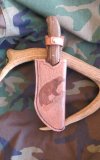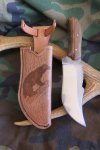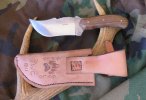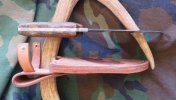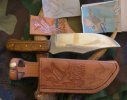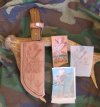In my videos I try to teach folks to recognize a potential problem and correct the issue before it has a chance to become the problem.
Having said that, way back in the beginning when you are developing your paper pattern make sure you designed at least 1/2" welt width which will later translate into ample room for a 1/4" stitch line from the edge AFTER you have squared up the edges PRIOR to grooving the stitch line. Squaring up the edges using a rotor sanding device (see thoughts below on hand sanding) will remove all the cement that was visible on the edge, and ordinarily removes about 1/32" of the former 1/2" available space.
AFTER this step you groove the stitch line ( I use 1/4" from the new edge.) Then after stitching I do the final finish on the edges.
Now, even before that, since you know there could be a cement/glue problem , be sure to exercise some extra caution when you apply the glue. This is not a place to be sloppy, be careful and precise in applying the glue to be being very mindful to keep it off surfaces that will be the exposed edges. If it's not there to begin with makes the job a lot easier.
Finally when you are squaring up the edges initially, (prior to stitch grooving) be very sure the edges are smooth and flat and all the cement has be removed. In the photo example above jwcustoms quit before he was finished.

This is a continuing occurrence when hand sanding to square and finish the edges. You tend to think,"this is tiresome and that's good enough".
Well, unless it's perfect, it's not "good enough" so don't stop until you are finished, and the edge is clean, square and perfect!
Once again, this is the way I do it, not the only way, and not necessarily the best way.......but it is
MY WAY.
Paul

